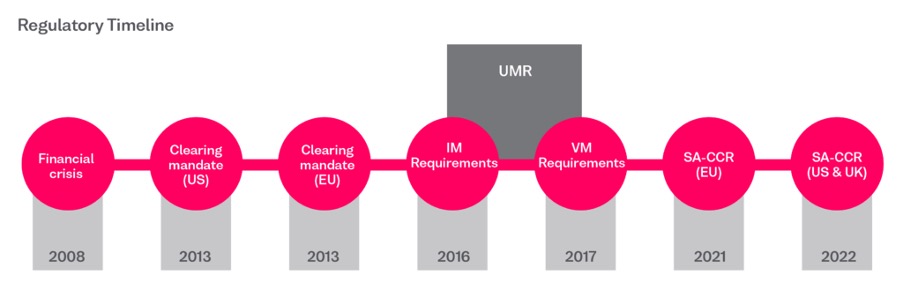There are a multitude of risk factors that contribute to the cost of trading OTC derivatives and maintaining a derivatives portfolio over time. As the industry transitions to the risk-based calculation method for capital requirements, referred to as SA-CCR, or Standardised Approach to Counterparty Credit Risk, join OSTTRA’s Erik Petri for an examination of how counterparty credit risk contributes to these costs, by highlighting the intricacies involved in OTC credit risk management.
By Erik Petri, Head of triBalance, OSTTRA

The importance of managing counterparty credit risk effectively became evident during the financial crisis 14 years ago. It subsequently became a central theme in the regulatory changes that followed, including mandatory central clearing, the requirement to secure non-cleared exposures via Variation Margin (VM) and Initial Margin (IM), and, most recently, the implementation of the updated capital regime, SA-CCR. Over time, each of these regulatory initiatives has increased the cost of counterparty credit risk, in turn incentivising effective risk management and proactive mitigation.
Mandatory clearing has made the financial markets more resilient by ensuring that liquid and vanilla risk is centralised, netted down, and facing a financially robust counterparty. However, risk exposures that were traditionally intended to hedge one another but originated from different product types is sometimes scattered between different netting sets, resulting in fragmentation since not all products are eligible, or indeed suitable, for clearing.
The advent of Uncleared Margin
After the introduction of the mandatory clearing rule, regulatory focus switched to the mitigation of bilateral risk, with firms required to exchange margin with their counterparties. This became mandatory for the largest firms in the first wave of the Uncleared Margin Rules (UMR) in 2016/17. UMR thrust counterparty risk back into the spotlight and the cost of funding initial margin has become a real consideration when maintaining an OTC portfolio.
Many of the most active FX trading participants witnessed their initial margin requirements quickly growing since FX positions are typically fragmented across many currency pairs, multiple counterparties and have historically only been cleared or netted to a limited extent. The UMR product scope differentiated between FX products, specifically those with and without physical delivery. This, again, impacted well managed netting sets as non-deliverable risk from FX instruments now attracted bilateral margin, whilst deliverable FX risk did not.
This encouraged the industry to reduce risk using a combination of pre- and post-trade optimisation tools, as well as promoting scalable initiatives to help achieve this. The resulting solutions optimise risk allocation between bilateral counterparties and the CCP(s), which reduces the size of margin calls and the associated funding costs. The clear benefits of these new multilateral services resulted in rapid adoption and incorporation into the banks’ daily operations. These initial solutions were very efficient, given the focus was purely on counterparty credit risk, and left market risk unchanged. In FX products alone, the cost savings achieved through the optimisation of credit risk amounts to savings exceeding USD 100 million annually.

Adoption of the SA-CCR capital regime
The recent introduction of SA-CCR as the standard capital measure for calculating counterparty credit risk altered the dynamics of FX credit risk again, adding another dimension to be considered when minimising the all-in-cost of trading. Existing risk management and optimisation solutions have been extended to include the additional complexity, and new solutions such as selective post trade novation, compression and clearing have been, and continue to be, analysed.
Actively managing FX exposures and counterparty risk for UMR and/or SA-CCR, or concentrating exposures by clearing, can reduce the associated risks and costs. However, the complexity of managing multiple measures and different types of netting-sets all need to be considered simultaneously if firms are to achieve the objective of minimising all-in derivative portfolio costs.

UMR and SA-CCR are both driven by counterparty credit risk, and each of them affects the cost of trading FX. They are interconnected and cannot be considered in isolation – active risk mitigation in one risk measure may result in an adverse impact on the other. They need to be addressed in tandem, not only because of their similarities but also because there are some important differences that are unique to the FX market:
• Different calculation models apply which makes the relative value of risk reduction different between SA-CCR and UMR
• The range of FX products included in each model differs
– SA-CCR covers all FX exposures and includes cross currency risk
– UMR exempt all deliverable FX risk and classify cross currency differently
• Legacy trade populations are treated differently
– SA-CCR covers all exposures irrespective of trade date
– UMR only applies to positions traded after each firm’s respective UMR implementation date
• Exposure thresholds applicable to UMR imply that exposures below a certain level do not trigger any margin calls, hence costs, whilst all SA
• CCR exposures require capital to be reserved
• Capital regulations in certain jurisdictions include a floor, for example the Collins floor for Risk Weighted Assets (RWA), calculated using internal models (IMM) which impacts the relative value of managing UMR, SA-CCR and IMM exposures

Managing the all-in cost of capital associated with OTC derivatives
FX exposures can, for the benefit of both UMR and SA-CCR or IMM, be simultaneously and independently optimised by leveraging the differences in instrument coverage. Clearing increases netting efficiency, reducing the size of outstanding exposures whilst causing deliverable FX transactions to attract additional margin requirements. These incremental costs must be considered when seeking to optimise the all-in cost of maintaining FX exposures via redistribution of counterparty risk, clearing, novation etc. These methods can all be used in isolation, but the best outcome is achieved when applied together to optimise and minimise the all-in cost.
Although some of these properties are specific to the FX market, others are common across asset classes. In interest rate markets for example, mandates have driven the majority of trades into clearing and the instrument scope for SIMM and SA-CCR is the same – thus the optimisation characteristics differ from the FX market.
There are also differences specific to individual firms that can be highlighted, and are important to consider when seeking to actively manage risk to reduce the all-in cost of counterparty credit risk:
• RWA calculation using standardised approach vs. internal model (IMM)
• Same risk weight facing all counterparties vs. different risk weight depending on counterparty
• Potential floor for IMM calculation of RWA capital requirements
• Leverage Ratio vs. RWA as constraining capital adequacy ratio
• Individual firm’s cost of funding margin vs. the cost of capital (ROE) impacts the value of optimising UMR/CCP IM vs. SA-CCR/IM
Summary – Significant complexity
The regulatory regime that governs counterparty credit risk contains multiple interdependent measures, applying to similar exposures, which must be considered in totality to avoid an undesirable outcome.
In reality, banks and firms are domiciled in different jurisdictions, have varying levels of portfolio complexity, and different funding costs. All these factors need to be managed concurrently when optimising counterparty credit risk and regulatory costs associated with OTC portfolios.
Complexity is high. To maximise the benefit of actively managing counterparty risk, firms need to apply their own individual preferences and drivers while simultaneously accounting for differences between UMR and SA-CCR, and bilateral and cleared exposures, for all the individual asset classes.
Given counterparties monitor risk in different ways, it is important to manage and optimise counterparty credit risk:
• in a large multilateral network facing multiple counterparties
• considering the many regulatory drivers and risk factors
• leveraging all available optimisation techniques, and
• using a process that provides maximum efficiency, repeatability & scalability
OSTTRA’s low touch, cross-asset class optimisation service targets multiple risk measure simultaneously. Learn more here:
https://osttra.com/sa-ccr/











